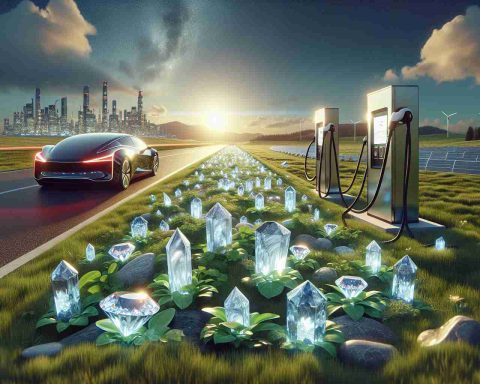Innovative Green Energy Solution for Remote Areas
In a groundbreaking initiative for sustainable transportation, Powerhouse has launched a 60 kVA off-grid solar array at the Whim Creek Hotel in the Pilbara region of northern Australia, located nearly 1,639 km from Perth. This remarkable project is part of the expansive 7,000 km Western Australia Electric Vehicle (WAEV) Network initiative.
The solar installation comprises high-efficiency JinkoSolar panels, along with two SMA string inverters that facilitate battery charging. To manage energy output, four Victron Quattro inverters discharge the stored energy to a 50 kW electric vehicle charger, which has the potential to be upgraded to a 75 kW fast charger. This EV charging station represents one of 110 fast chargers being strategically placed across 49 locations as part of a larger project supported by the Western Australian government.
Working in extreme summer heat, often reaching 50°C, Powerhouse crews meticulously installed the 106-module setup during nighttime hours. This strategic choice not only ensures worker safety but also demonstrates the team’s commitment to overcoming geographical and climatic challenges.
Powerhouse founder Brigette McDowell emphasized the need for meticulous planning and multi-skilled teams for such remote installations. Following their success at Whim Creek, Powerhouse has expanded its efforts, adding a new charger at the Mundrabilla Roadhouse, demonstrating a relentless pursuit of sustainable energy solutions across the Aussie outback.
Broader Impacts of Sustainable Energy Initiatives
The deployment of innovative green energy solutions, such as the solar array in the remote Pilbara region, exemplifies a shift toward sustainability that carries profound implications for society and culture. By providing off-grid energy solutions, it enhances accessibility to electric vehicle (EV) charging infrastructure in previously underserved areas. This does not merely foster eco-friendly transportation but also encourages regional economic development, inviting new businesses and tourism to locales like Whim Creek.
The global economy stands to benefit as well. As countries race toward carbon neutrality, such projects serve as a blueprint for combining renewable energy with electric mobility. This alignment is essential in reducing reliance on fossil fuels, while simultaneously supporting the EV market’s growth. By integrating green energy solutions into their transportation networks, nations can also strengthen their energy independence, thereby mitigating vulnerability to energy price fluctuations.
The environmental benefits are similarly noteworthy. The reduction in greenhouse gas emissions from transitioning to electric vehicles is significant. However, this initiative also highlights the urgency of addressing challenges such as battery recycling and the environmental footprint of solar technologies.
Looking to the future, the potential for scalable models arising from these projects could catalyze more widespread adoption of renewable technology, paving the way for a sustainable, interconnected, and resilient global economy.
Revolutionizing Energy Access: Powerhouse’s Solar Innovations for Remote Australia
Innovative Green Energy Solution for Remote Areas
In an exciting development for sustainable energy, Powerhouse has successfully launched a 60 kVA off-grid solar array at the Whim Creek Hotel in the Pilbara region of northern Australia. This initiative stands as a significant component of the extensive 7,000 km Western Australia Electric Vehicle (WAEV) Network project, which aims to enhance electric vehicle (EV) infrastructure in the region.
Key Features of the Solar Installation
The solar array features high-efficiency JinkoSolar panels, known for their reliability and energy output. It includes two SMA string inverters that support effective battery charging while maintaining optimal performance in challenging environmental conditions. To maximize energy management, the installation utilizes four Victron Quattro inverters, which deliver power to a 50 kW electric vehicle charger. Notably, this charger has the upgrade capability to become a 75 kW fast charger, catering to increasing EV demands.
This electric vehicle charging station is part of a broader initiative, with 110 fast chargers being deployed across 49 strategically selected locations throughout Western Australia, bolstered by government support. The accessibility of these chargers is vital for promoting sustainable transportation in remote areas.
Challenges and Innovations in Extreme Conditions
Powerhouse crews faced extreme conditions during the installation, with summer temperatures soaring to 50°C. To ensure worker safety and efficiency, installation work was strategically scheduled for nighttime. This approach not only underscored the team’s dedication to best practices in extreme environments but also showcased their innovative spirit in overcoming geographical and climatic obstacles.
Brigette McDowell, the founder of Powerhouse, highlighted the importance of meticulous planning and the deployment of multi-skilled teams for successful remote installations. Following the accomplishments at Whim Creek, Powerhouse’s commitment to sustainable energy has led to the recent addition of another EV charger at the Mundrabilla Roadhouse, further advancing the initiative across Australia’s outback.
Use Cases and Future Trends
This solar energy setup has multiple implications for sustainable travel in remote regions. By providing charging points for electric vehicles, it enhances the feasibility of long-distance travel and encourages more residents and travelers to adopt electric vehicles. It also contributes positively to the environment by reducing reliance on fossil fuels.
As this project progresses, we can expect to see increased integration of renewable energy solutions in remote areas, further promoting sustainability and access to clean energy.
Market Analysis and Sustainability Insights
The emergence of solar-powered charging stations represents a crucial trend in the renewable energy market, particularly in regions with limited infrastructure. Such initiatives not only foster sustainability but also offer economic opportunities in terms of job creation and the boost of local tourism through improved accessibility.
Additionally, this project aligns with broader global trends aiming for significant reductions in carbon emissions. As governments and organizations recognize the importance of renewable energy, investments in solar technologies are expected to increase, enhancing energy security and independence, especially in isolated regions.
Conclusion
The launch of the solar array at Whim Creek Hotel marks a pivotal moment in the movement towards sustainable transportation in remote areas. As Powerhouse continues to innovate and expand its efforts throughout Australia, the implications for environmental sustainability and energy access in rural communities cannot be overstated. These advancements not only set the groundwork for future initiatives but also exemplify a growing commitment to a greener planet.
For more information on sustainable energy solutions, visit Powerhouse.













